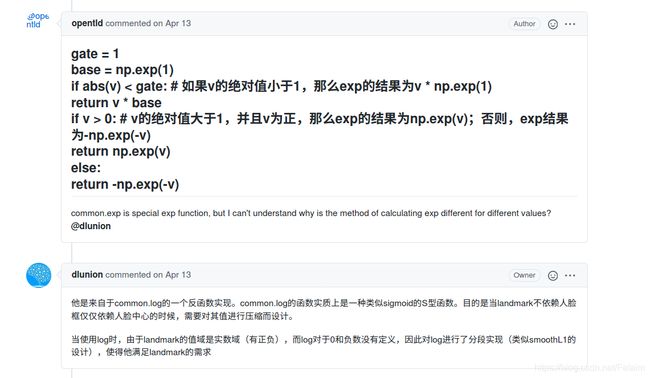DBFace: 源码阅读(三)
7 推断部分
推断部分主要是在test.py中
主要函数其实很短,如下,代码其实被我改了一部分,和原始的github上可能有点区别
mean = [0.408, 0.447, 0.47]
std = [0.289, 0.274, 0.278]
# trial_name = "small-H-dense-wide64-UCBA-keep12-noext-ignoresmall2"
trial_name = "mv2-320x320-without-wf_20200811"
jobdir = f"jobs/{trial_name}"
image = common.imread("imgs/selfie.jpg")
model = DBFace(has_landmark=True, wide=64, has_ext=True, upmode="DeCBA")
model.load(f"{jobdir}/models/74.pth")
model.eval()
model.cuda()
outs = eval_tool.detect_image(model, image, mean, std, 0.2)
outs = nms(outs, 0.2)
print("objs = %d" % len(outs))
for obj in outs:
common.drawbbox(image, obj)
common.imwrite(f"{jobdir}/result.jpg", image)
print("ok")
model.load()下载对应的模型,推断最主要的函数是
outs = eval_tool.detect_image(model, image, mean, std, 0.2)
我们来看下detect_image函数:
def detect_image(model, image, mean, std, threshold=0.4):
# pad主要是因为网络推断中stride=32,所以为了保证可以上采样回去,需要进行pad操作
image = common.pad(image)
#预处理操作
image = ((image / 255 - mean) / std).astype(np.float32)
image = image.transpose(2, 0, 1)
image = torch.from_numpy(image).unsqueeze(0).cuda()
# 推断
center, box, landmark = model(image)
#得到结果回归框中心点的heatmap,通过sigmoid来得到0-1
center = center.sigmoid()
box = torch.exp(box)
# debug
# center = F.max_pool2d(center, kernel_size=3, padding=1, stride=1)
return detect_images_giou_with_netout(center, box, landmark, threshold)
我们再来看下detect_images_giou_with_netout这个函数:
def detect_images_giou_with_netout(output_hm, output_tlrb, output_landmark, threshold=0.4, ibatch=0):
stride = 4
_, num_classes, hm_height, hm_width = output_hm.shape
hm = output_hm[ibatch].reshape(1, num_classes, hm_height, hm_width)
tlrb = output_tlrb[ibatch].cpu().data.numpy().reshape(1, num_classes * 4, hm_height, hm_width)
# landmark = output_landmark[ibatch].cpu().data.numpy().reshape(1, num_classes * 10, hm_height, hm_width)
landmark = output_landmark[ibatch].cpu().data.numpy().reshape(1, num_classes * 50, hm_height, hm_width)
# 使用最大池化来筛选值
nmskey = _nms(hm, 3)
# 选出top值2000,人脸较多的情况下值可以大一些,但是如果人脸比较少,或者图像比较小,建议还是小一些
kscore, kinds, kcls, kys, kxs = _topk(nmskey, 2000)
kys = kys.cpu().data.numpy().astype(np.int)
kxs = kxs.cpu().data.numpy().astype(np.int)
kcls = kcls.cpu().data.numpy().astype(np.int)
key = [[], [], [], []]
for ind in range(kscore.shape[1]):
score = kscore[0, ind]
if score > threshold:
key[0].append(kys[0, ind])
key[1].append(kxs[0, ind])
key[2].append(score)
key[3].append(kcls[0, ind])
imboxs = []
if key[0] is not None and len(key[0]) > 0:
ky, kx = key[0], key[1]
classes = key[3]
scores = key[2]
for i in range(len(kx)):
class_ = classes[i]
cx, cy = kx[i], ky[i]
x1, y1, x2, y2 = tlrb[0, class_ * 4:(class_ + 1) * 4, cy, cx]
x1, y1, x2, y2 = (np.array([cx, cy, cx, cy]) + np.array([-x1, -y1, x2, y2])) * stride
# 根据关键点个数进行修改
# x5y5 = landmark[0, 0:10, cy, cx]
# x5y5 = np.array(common.exp(x5y5 * 4))
# x5y5 = (x5y5 + np.array([cx] * 5 + [cy] * 5)) * stride
# boxlandmark = list(zip(x5y5[:5], x5y5[5:]))
x5y5 = landmark[0, 0:50, cy, cx]
#注意这个exp()
x5y5 = np.array(common.exp(x5y5 * 4))
x5y5 = (x5y5 + np.array([cx] * 25 + [cy] * 25)) * stride
boxlandmark = list(zip(x5y5[:25], x5y5[25:]))
imboxs.append(common.BBox(label=str(class_), xyrb=common.floatv([x1, y1, x2, y2]), score=scores[i].item(),
landmark=boxlandmark))
return imboxs
最后将返回得到的候选框和关键点坐标在通过nms进行处理
def nms(objs, iou=0.5):
if objs is None or len(objs) <= 1:
return objs
objs = sorted(objs, key=lambda obj: obj.score, reverse=True)
keep = []
flags = [0] * len(objs)
for index, obj in enumerate(objs):
if flags[index] != 0:
continue
keep.append(obj)
for j in range(index + 1, len(objs)):
if flags[j] == 0 and obj.iou(objs[j]) > iou:
flags[j] = 1
return keep
使用NMS来去除冗余的框,得到最后的结果
当中,其实有些细节,例如关键点的后处理要进行exp():
def exp(v):
if isinstance(v, tuple) or isinstance(v, list):
return [exp(item) for item in v]
elif isinstance(v, np.ndarray):
return np.array([exp(item) for item in v], v.dtype)
gate = 1
base = np.exp(1)
if abs(v) < gate:
return v * base
if v > 0:
return np.exp(v)
else:
return -np.exp(-v)
为什么呢?我们来看下作者是怎么解释的?

第三篇还是有些细节是需要注意的,后面一篇写下转caffemodel?还是其他呢。。。